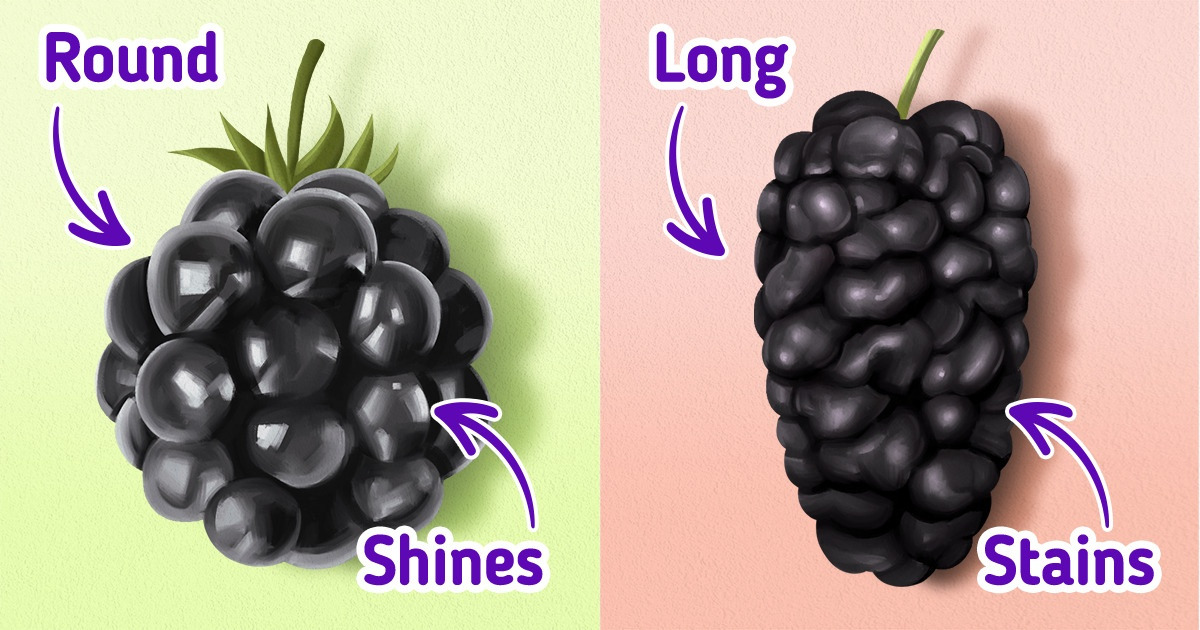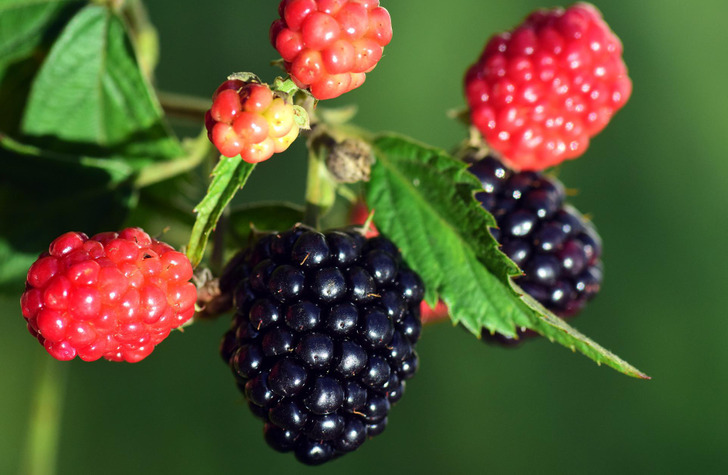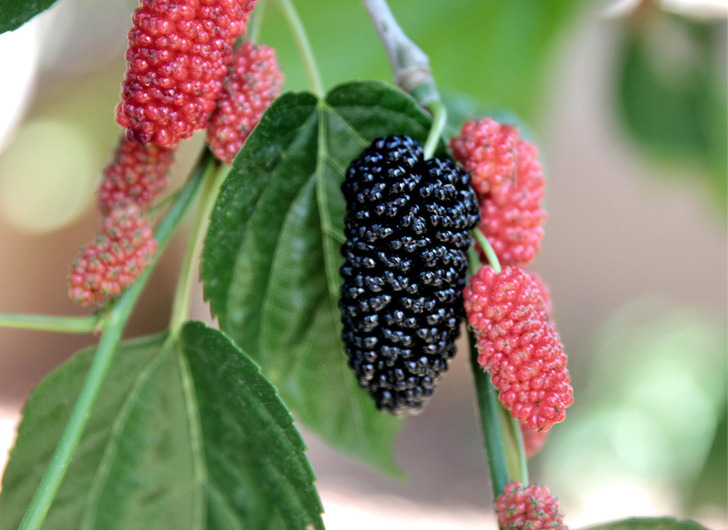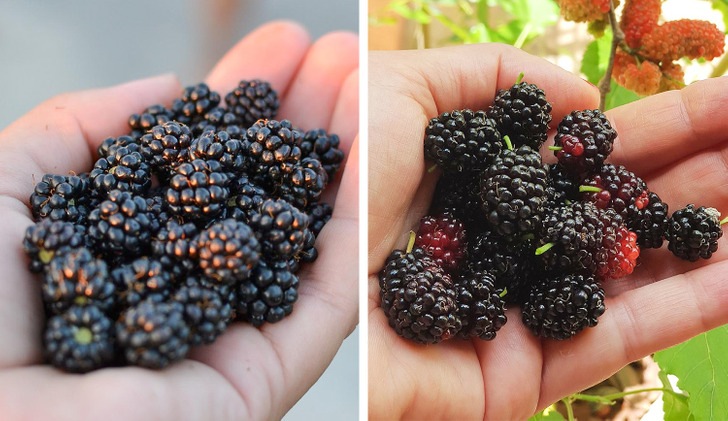How to Tell Blackberries From Mulberries

It’s summer — the season when we can treat ourselves to fresh veggies, fruits, and berries. By the way, some of them are so alike that we often mix them up. For example, not many people can distinguish peaches from nectarines, blueberries from bilberries, and blackberries from mulberries.
5-Minute Crafts has already told you about the differences between the first 2 pairs. Today you’ll learn to tell blackberries from mulberries and learn about their healthy properties.
Blackberries
We tend to consider blackberries berries, but this is actually not true. Blackberries are what’s called aggregate fruit. A berry is a fruit that develops from a single ovary inside a single flower, like grapes for example. Aggregate fruit develops from multiple carpels (the parts of flowers that hold seeds) from a single flower and then these grow together into aggregate fruit. Nevertheless, blackberries are called berries among ordinary people.
Where they grow. Blackberries are a perennial shrub of the genus Rubus that also includes roses and raspberries. It is successfully grown in many areas of North America and Europe.
How they bloom. Blackberries bloom with white and pale pink flowers from late spring to the beginning of summer.
When they ripen. Blackberries normally start to ripen in July or August unless it’s an early ripening variety. Its fruits change their color as they ripen. Unripe berries are green, then they turn red and start to get dark. Ripe blackberries look like dark-purple berries that have an almost black color.
How they look. Small berries have a round shape but they become oval as they grow.
Size. Blackberries differ by size but their length is usually 1 inch long and ½-1 inch in diameter.
Taste. Blackberries have a slightly sour taste and become sweeter as they ripen.
Benefits. Blackberries contain antioxidants, vitamins (such as C, E, K), calcium, and manganese. They also contain antioxidants like anthocyanins have anti-inflammatory and antimicrobial properties.
Moreover, blackberries have a good effect on the body, they:
- improve digestion due to the high content of insoluble fiber.
- have a positive effect on insulin resistance and triglyceride levels. Experts consider blackberries useful in the treatment of diabetes, especially when eaten fresh or frozen.
- help fight obesity, increase insulin sensitivity, and promote more efficient fat burning in the body.
Mulberries
Mulberries are also not berries. In fact, they are multiple or collective fruits. Normally (in other fruits) a single flower produces a single berry. In mulberries, each berry is formed from multiple different flowers that fuse together. Another example of a multiple or collective fruit is pineapple. Still, mulberries, just like blackberries are called berries.
Where they grow. Mulberries grow on Mulberry trees of the Morus genus. This is a medium-sized deciduous tree. It has large heart-shaped leaves with serrated margins.
Mulberries originated in China but today they are cultivated all around the world. In China, silkworms feed on the leaves of this tree. The more they eat, the more silk they produce.
Types of mulberries. There are many varieties of mulberries but the most common are:
- red
- white
- black
How they bloom. Mulberries start to bloom in spring. The flowers look like clusters of tiny white or green flowers growing on a short spike or catkin. In May, mulberry flowers turn into clusters of tiny, seeded fruits that make up the berries.
When they ripen. Mulberries ripen in summer, harvesting normally starts in the middle of June.
How they look. Mulberries have an oval shape. They can be white, black, or red-purple in color. One should be careful with mulberries — the juice of dark berries can stain skin, teeth, hands, and clothes. This is the reason why mulberries shouldn’t be planted along pathways and driveways.
Size. Mulberries are much larger than blackberries. Depending on their type, they can grow between 1″ and 3″ long.
Taste. Mulberries have a sweet taste. But it can differ in different types of mulberries. For example, white mulberries are very sweet, while darker types have a tart-sweet taste.
Benefits. Mulberries contain vitamins, antioxidants, and minerals like magnesium, phosphorus, potassium, calcium, and iron. Mulberries have a positive effect on health, they:
- help regulate cholesterol levels, thereby reducing the risk of atherosclerosis of the heart vessels.
- reduce the likelihood of cognitive decline, thus maintaining brain health due to the high level of flavonoids.
- help prevent various age-related eye diseases, again due to flavonoids
- contain vitamin C, which plays an important role in preventing cataracts and in the production of the collagen that is responsible for the functioning of joints, ligaments, and bones, and for the quality of the skin.
Mulberries go bad quickly and have very thin skin, so they must be handled very carefully.
Main differences between blackberries and mulberries
- Mulberries grow on trees, blackberries grow on bushes.
- The width of mulberries is almost the same as blackberries, but the length is almost twice as long.
- Not only are mulberries longer than blackberries but they also have a more oval shape.
- Blackberries are shorter and rounder than mulberries.
- Blackberries are shinier than mulberries.
- Mulberries are usually sweeter than blackberries.
- Mulberry juice stains a lot, unlike blackberry juice.
- Plucked mulberries have a green stalk.


